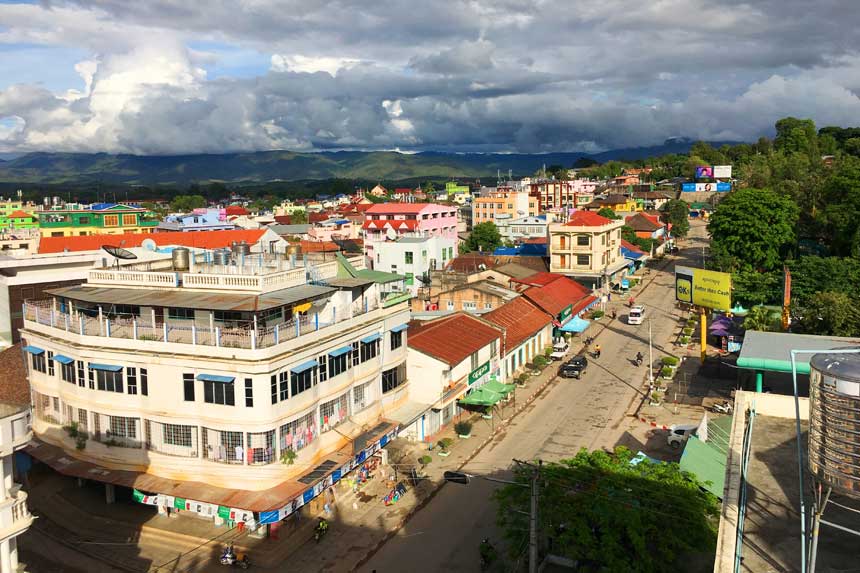Kyaing Tong is known for its scenic beauty and many colorful ethnic tribes. Places of interest around Kyaingtong are, the Spa, Naung Tong Lake, Sunn Taung Monastery, Central market and Traditional Lacquer ware works and weaving factory.
There are many villages of various ethnic tribes resided around Kyaing Tong. The tribes known as Gon, Lwe, Li, Wa, Lah Hu, Thai Nay, Shan, Li Shaw, Li Su, Palaung, Akha, and we can only differentiate the tribes by colourful dresses which is different to one another.
Can observe their tribal dances and their way of living on these mountainous regions around Kyaing Tong. Situated in the eastern Shan State and 452 km from Taunggyi and 176km from Tachileik.
Nearby Attractions
THE MAHA MYAT MUNI OF KYAING TONG (WAT PRA SAO LOANG)
This was my second visit to Kyainge Tong , the principal city of Shan State (East) and the second golden opportunity to pay homage to the Maha Myat Muni Image of Kyainge Tong Members of the Board of Editors of the Myanmar Perspectives magazine had set out on a study tour of Tachilek and Kyainge Tong through the kind offices of the authorities concerned and had arrived in Kyainge Tong from Tachilek on the afternoon of December 27, 1997. The Maha Myat Muni Pagoda was just around the corner from the Kyainge Tong Hotel, so a group of us walked there after dinner. The pagoda or temple to put it more accurately, though not located in the heart of town, reminded me of Sule Pagoda because it stands encircled by a good motor road and motor cycle traffic was heavy. But once you entered the prayer hall of the Maha Muni Image the atmosphere is tranquil and one can meditate and pray in peace. The walls and ceiling of the hall are resplendent with ” Shwezawa” (gold lacquer) decorations yet it was not so lavish as to offend the eye. Then wemet some members of the Board of Pagoda Trustees who welcomed us warmly and were each given an information booklet in English on the history of the pagoda. We met the translator of this booklet from the Shan to English Sai Loang Gyi and at his request I would like to recount to our readers the legend which led to sculpture of images in kingly robes as well as the origin of the Maha Muni Pagoda – a noble and serene effigy of the Lord Buddha.
The Legend It says in the booklet that – ” During thelifetime of the Gotama Buddha there lived a heretic king named “Pyar Zoombu” (Zabupadi in Myanmar) who was so filled with arrogance, vanity and pride that he even refused to pay obeisance to the Lord Buddha.”
The Lord Buddha in his omniscience realized that this handsome king, though blinded by his own pride and power, had the seed of wisdom lying dormant in him which could flower and bear fruit to set him free from lust anger and ignorance. So the Lord Buddha one day appeared before him in kingly attire with a richly jewelled crown and intricately ornamented gold sash,
seated majestically on a magnificent throne. The Buddha in this form epitomised a grandeur and power immeasurably beyond that of “Pya Zoombu”. The king was thus jolted out of his egocentricism and eventually repented and became a devoted disciple of the Buddha. To commemorate this incident, the king of Dinnyawaddy (Rakhine) and the local people immediately cast a replica image in bronze. The Buddha image later came to be known as the Maha Muni.
The Origin of the Kyainge Tong Maha Myat Muni After many years had elapsed the news of the image spread from Rakhine to kyainge Tong. For the perpetuation and dissemination of the Buddha’s teachings, Sao Kawn Kaio Intaleng, the then chief ruler of Kyainge Tong called upon Art Yar Tum, the Patriarch of Wat Zaing Ngam, town elders and townspeople to assist him in his plan to have such an image cast for worship.
The Casting of the Buddha Image In 1282 of the Myanmar Era (1920 A.D.), Saophaloang Sao Kawn Kaio Intaleng sent two high-ranking officials in his service, U Pho Mein and U Banyar Pyar Wat to Mandalay to commission work on the image with bronze casters of Mandalay. Thus the Buddha image was cast in Mandalay in 1283ME (1921 A.D.) by skilled artisan U Tit and fellow workers. The face of the Image from the chin to the topmost part of the holy head was cast from a mixture of 1.7 viss ( 1 viss = 3.6 pounds) of pure gold, 17 viss of silver and some copper. The total cost was 15,000 colonial rupees. At the time the Takaw-Kyainge Tong road was merely a buffalo track, so the image had to be transported in separate parts. It was transported with great difficulty from Hsipaw to Takaw, a village situated on the western bank of the Thanlwin river by bullock cart, and from Takaw to Kyainge tong by buffalo cart. The people of the town were said to have turned out in full force to joyously welcome and pay homage amidst the rhythmic beating of gongs and the deep throated bonging of the Shan long drum. It was conveyed in procession around town and set up in residence at a thatched Vihara at Koang Kwai Zon, now the football ground in the town’s centre. It was kept in the temporary Vihara for over a year.
In 1926 the Buddha Image was moved from the temporary thatched Vihara to the present building. This new Vihara had a roof of teak wood shingles with a ceiling of thick planks. A brick wall was also built to enclose the precincts. In 1938, it was again renovated and the roof replaced with a splendid tapering nine-tiered roof. The inside walls were also elaborated with froral designs. The donor was the then Mahadevi of Kyainge Tong.

